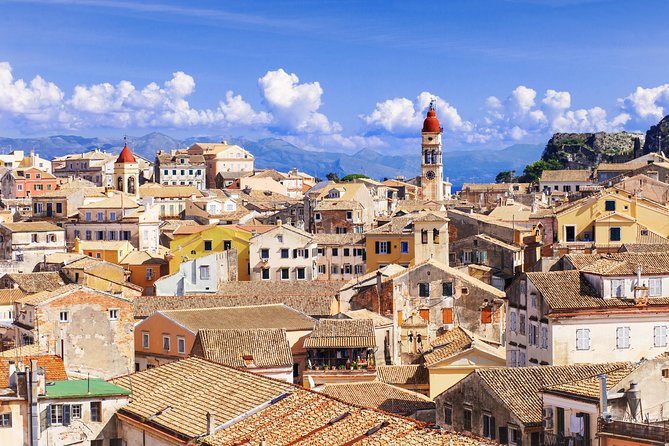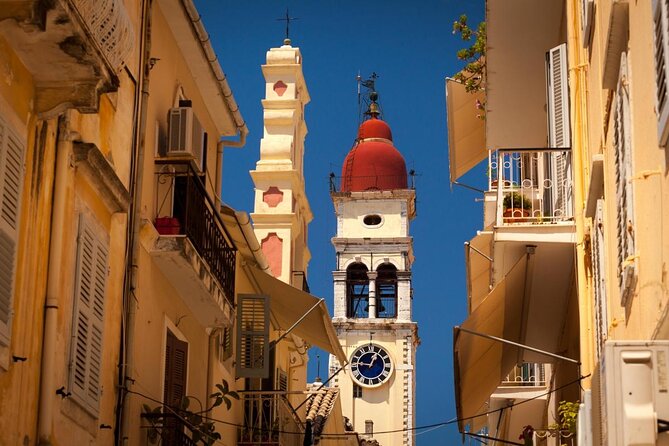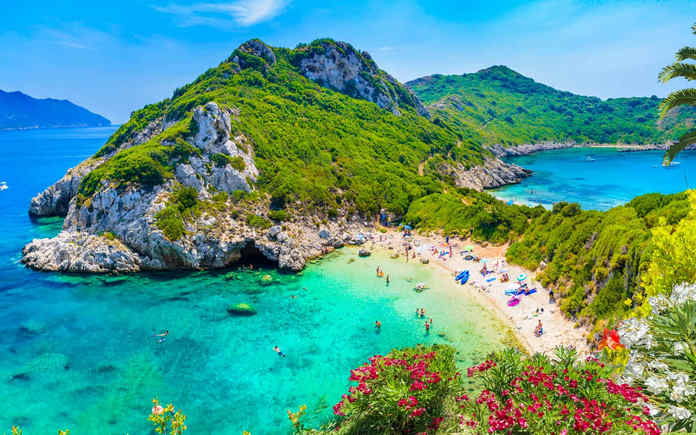There is a small bay on Corfu with pure white sand and all around it a mountain with thick vegetation. A stream flows past and flows into the sea. According to tradition, on this sandy beach, Nausica, the daughter of King Alcinous, found the shipwrecked Odysseus and took care of him. The bay, Ermones, looks exactly like the one Homer described in Odyssey where he speaks about the final stop of Odysseus in the land of Phaeacians, Corfu.

Known since the time of Homer, Corfu later became even more famous. Royalty around Europe adopted it for their summer residences. Elisabeth of Austria, the famed Sissy, bought a palace there. Since then more and more travelers have visited the island and spoken with enthusiasm about the natural beauty of Corfu and the politeness and culture of the inhabitants.
Corfu has slowly gone from being an island of mainly farming population to an international tourist center.
The vegetation consists mainly of olive and cypress trees. Olive oil is the main product of the island and is considered to be the best in Greece. Other products are milk, butter, cheese, white wine, and processed meats. There is one product that is produced only in Corfu, nowhere else in Europe. It’s cumquat, a small orange of Chinese origin that is used to make different sweets or liquors.
Traditional folk art continues to be cultivated on the island. Its products are woven items, rugs, wickerwork, silverware, and jewelry.
 The Town of Corfu
The Town of Corfu
It’s one of the loveliest towns in Greece, it’s the capital of the island and at the same time the like-named prefecture. Fortified since ancient times, the town’s castles still exist which were built by ancient Corfiots and the Byzantines.
Its streets may still carry the sounds of distant clashes but today they are ruled by high spirits, music, and beauty.
West of the Old Fortress, the largest and most striking square in Greece, the renowned Spianada flanked by wonderful old buildings. On the north side of Spianada is the palace of the English Lord High Commissioner which today houses the Museum of Asian Art. On the west side of Spianada is the well-known Liston, a building constructed during the period of French occupation with an arched colonnade, cafes, and restaurants. The Liston is the best-known meeting place for locals, and foreigners alike.

Agios Spyridonas street begins behind its north end; this is where the church of the patron saint of the island is (16th century) and where his relic is kept. Evgeniou Voulgareos street which begins at the south end of the Liston leads to the City Hall, a beautiful Venetian building (17th century), and the Church of St. Jacob. the Catholic cathedral (17th century).
Near Agios Spyridonas is Panagia Spiliotissa, the Greek Orthodox cathedral (16th century). Proceeding north from here you reach the old harbor from where the ferry boats depart for Igoumenitsa.
The old town is tightly squeezed into the area between Spianada and the New Fortress. That’s why the houses were multi-storeyed with very narrow streets between them, so narrow that often the clothesline from one house is tied to the opposite one.
The Archaeological Museum which contains finds from the whole island is on the south side of Spianada near the shore at the Bay of Garitsa.
 Top attractions in Corfu:
Top attractions in Corfu:
1. Corfu beaches
Corfu has plenty of beaches for everybody’s taste. All of them offer crystal waters and stunning rock formations. One of the most popular villages for beachgoers is Paleokastritsa.
2. Achilion Palace and Museum
Originally built in 1890 of the Austrian Empress the property features statues of Greek gods in its gardens and frescoes and artwork in the interior.
3. Paleokastritsa monastery
The monastery was built in 1200 and is dedicated to the Virgin Mary. Inside the monastery, there is a little museum of Byzantine icons, books, and other relics. This place is a great location for taking pictures of sweeping views of the ocean.
4. Old Fortress
The fortress was built in the 14th century by Venetians and is separated from the Corfu town by a moat. It’s a great place for breathtaking views of the city and its surroundings.
5. Church of St. Spyridon
The church is named after the patron saint of the island, St Spyridon. To honor the saint, most male population in Corfu is named “Spyros”. The remains of the saint can be found inside the church. The red bell tower is also the highest point in the town.
6. Canal d’Amour
This is one of Corfu’s most famous natural wonders. Sandstone rock formations create a natural passage from the small beach into the Ionian sea.
7. Mount Pantokrator
Mount Pantokrator is the highest point of the island. It rises 906m above sea level. At the top of the mountain, you will find a Pantokrator monastery that dates back from the 14th century. The views from the top are stunning as you can see Albania, Diapontia islands to the north, and Paxos and Antipaxos islands to the south.